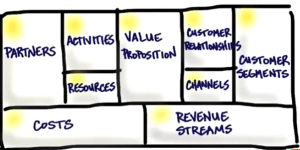
A model is defined a guiding framework for the successful achievement of an objective. Business modelling brings into harmony the target market, products and resources available as key drivers for the success of an enterprise, and should be at the heart of every business start-up. This, naturally, follows the selection of a business opportunity to pursue as derived in a critical SWOT analysis. It is the roadway to monetize (identify ways to get paid) the operations of the business idea for sustainability in line with the established objectives.

A business modelling canvas (BMC) is a graphical representation of the business idea and should be the basis for the documentation of a business plan where one is warranted, such as when requested by bankers and investors. The modelling canvas may serve as an end in itself, where third parties may not require documentation, but it should be supported by organizational structures and financial projections/estimates to avoid cash flow surprises.
The nine elements of the BMC are as shown above and comprise:
- Customer segments
- Revenue model
- Customer relationships
- Channels
- Value proposition
- Key activities
- Key resources
- Key Partners
- Cost Structure
Customer Segments

Identify the customers to be served, qualified by reachability and ability to purchase. Also consider the resource limitations for the company in meeting a potential excessive demand and possible loss of goodwill. In this regard, it is best to consider the best possible niche, initially.
Revenue Streams

Provide questions to what values the customers are paying for. Various models include:
- possibly free or at a highly subsidized cost equipment (such as vacuum machine) for future sales of supplies. Some car companies also capture first time buyers with lifetime contracts for future trade ins.
- Intellectual property -Such as annual licencing fees for use of a software
Customer Relationships

Identification of the most efficient methods to capture and hold customers for repeat business. Start-ups also need to look into more ways that they can get a bigger share of the customers’ spending without diluting the brand positioning.
Channels

Methods by which the business offerings will reach the customer. Options may include wholesaler-retailer, drop-shipping, online, outsourced commissions’ companies or in-house sales teams. Others include drive-through for restaurants and at-home services.
Value Proposition

Considers value delivered to the selected market segments and may include newness, performance, ability to customize (such as software for corporate specific needs), exclusivity (needs high price) and convenience (such as at-home services or delivery).
Key Activities

Key operational and logistical requirements for the operational needs of the enterprise. This many include manufacturing, 24-hour phone support and management of supply chains. Consideration should be made to outsource to organizations that may be more efficient where the firm may lack expertise.
Key resources

Consider physical assets (real estate, vehicles, furnishings), intangible assets (patents and copyrights), human resources and financial resources.
Key Partners

Includes alliances, joint ventures, out-sourcing and suppliers (including farmers for specific quality or supply guarantees), manufacturers, retailers, regional exclusive licences and franchisees (branded retailers).
Cost Structure

Here, key resources are matched to the related costs. An example are free magazines, with the revenues derived from advertisers. The costs of publishing and distribution need facilitate the targeted returns to owners. The magazines also need to pay for out-sourced content creators or hire in-house talent for to attract readers, which forms the basis for marketing to advertisers based on readership demographics.
Strong need to enhance variability of costs as much as possible in the immediate term and also consider economies of scales.
The BMC is therefore critical for the success of any business venture, providing key advantages that include; it is easy to understand, focussed, flexible, customer focussed and graphical (shows connections), hence easy to communicate.
Authored by Sam Kagiri (info@benkenya.com)-04/05/2023
